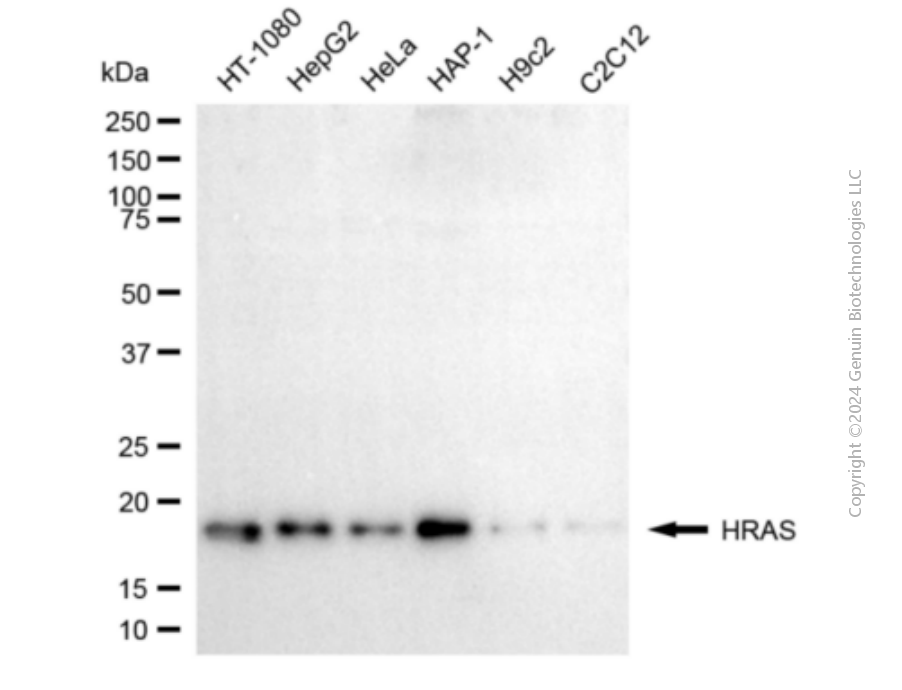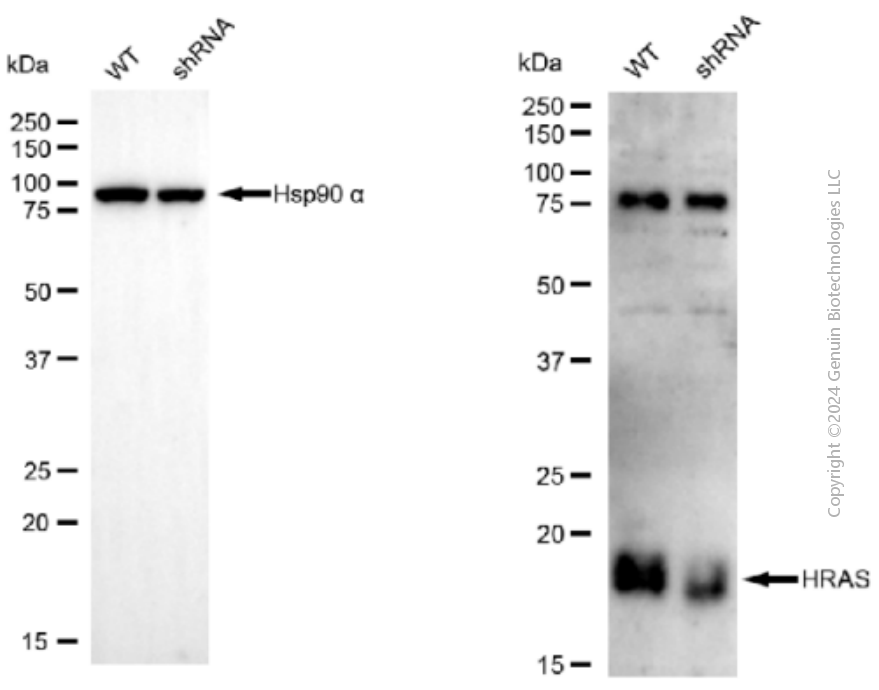KD-Validated Anti-HRAS Mouse Monoclonal Antibody
Mouse monoclonal antibody
- SPECIFICATION
- CITATIONS
- PROTOCOLS
- BACKGROUND

Application
| WB |
|---|---|
| Primary Accession | P01112 |
| Reactivity | Rat, Human, Mouse |
| Clonality | Monoclonal |
| Isotype | Mouse IgG1 |
| Clone Names | 24GB5695 |
| Calculated MW | Predicted, 21 kDa, Observed, 18 kDa |
| Gene Name | HRAS |
| Aliases | HRAS; HRas Proto-Oncogene, GTPase; HRAS1; V-Ha-Ras Harvey Rat Sarcoma Viral Oncogene Homolog; Harvey Rat Sarcoma Viral Oncogene Homolog; Transforming Protein P21; GTPase HRas; P21ras; Ras Family Small GTP Binding Protein H-Ras; Harvey Rat Sarcoma Viral Oncoprotein; Transformation Gene: Oncogene HAMSV; GTP- And GDP-Binding Peptide B; Ha-Ras1 Proto-Oncoprotein; C-Has/Bas P21 Protein; P19 H-RasIDX Protein; EC 3.6.5.2; C-BAS/HAS; C-HA-RAS1; H-RASIDX; C-H-RAS; H-Ras-1; C-H-Ras; Ha-Ras; HAMSV; RASH1; CTLO |
| Immunogen | Recombinant protein of human HRAS |
| Gene ID | 3265 |
|---|---|
| Other Names | GTPase HRas, 3.6.5.2, H-Ras-1, Ha-Ras, Transforming protein p21, c-H-ras, p21ras, GTPase HRas, N-terminally processed, HRAS, HRAS1 |
| Name | HRAS |
|---|---|
| Synonyms | HRAS1 |
| Function | Involved in the activation of Ras protein signal transduction (PubMed:22821884). Ras proteins bind GDP/GTP and possess intrinsic GTPase activity (PubMed:12740440, PubMed:14500341, PubMed:9020151). |
| Cellular Location | Cell membrane {ECO:0000250|UniProtKB:P20171}; Lipid-anchor; Cytoplasmic side. Golgi apparatus. Golgi apparatus membrane; Lipid-anchor. Note=The active GTP-bound form is localized most strongly to membranes than the inactive GDP-bound form (By similarity). Shuttles between the plasma membrane and the Golgi apparatus. |
| Tissue Location | Widely expressed.. |

Thousands of laboratories across the world have published research that depended on the performance of antibodies from Abcepta to advance their research. Check out links to articles that cite our products in major peer-reviewed journals, organized by research category.
info@abcepta.com, and receive a free "I Love Antibodies" mug.
Provided below are standard protocols that you may find useful for product applications.
If you have used an Abcepta product and would like to share how it has performed, please click on the "Submit Review" button and provide the requested information. Our staff will examine and post your review and contact you if needed.
If you have any additional inquiries please email technical services at tech@abcepta.com.














 Foundational characteristics of cancer include proliferation, angiogenesis, migration, evasion of apoptosis, and cellular immortality. Find key markers for these cellular processes and antibodies to detect them.
Foundational characteristics of cancer include proliferation, angiogenesis, migration, evasion of apoptosis, and cellular immortality. Find key markers for these cellular processes and antibodies to detect them. The SUMOplot™ Analysis Program predicts and scores sumoylation sites in your protein. SUMOylation is a post-translational modification involved in various cellular processes, such as nuclear-cytosolic transport, transcriptional regulation, apoptosis, protein stability, response to stress, and progression through the cell cycle.
The SUMOplot™ Analysis Program predicts and scores sumoylation sites in your protein. SUMOylation is a post-translational modification involved in various cellular processes, such as nuclear-cytosolic transport, transcriptional regulation, apoptosis, protein stability, response to stress, and progression through the cell cycle. The Autophagy Receptor Motif Plotter predicts and scores autophagy receptor binding sites in your protein. Identifying proteins connected to this pathway is critical to understanding the role of autophagy in physiological as well as pathological processes such as development, differentiation, neurodegenerative diseases, stress, infection, and cancer.
The Autophagy Receptor Motif Plotter predicts and scores autophagy receptor binding sites in your protein. Identifying proteins connected to this pathway is critical to understanding the role of autophagy in physiological as well as pathological processes such as development, differentiation, neurodegenerative diseases, stress, infection, and cancer.



